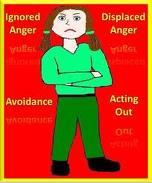How to Manage Your Anger Effectively

Do you suffer from frequent bouts of uncontrolled anger? Get red in the face every time someone overtakes you on the road? Fist your hands into tight balls when your spouse or child challenges you? Feel insulted when criticized? Lash out at waiters if your order gets mixed up? honk your horn repeatedly in a traffic jam? Hate the "attitude" of the kid next door?
If you do suffer from an inability to deal with your anger, you have left a big part of yourself unchecked, uncontrolled and potentially dangerous
Recognizing and Accepting Anger
It's important to recognize anger as a legitimate emotion. Anger is programmed in, just like hunger and thirst and lust and love. It's a strong feeling and feelings are facts. Feeling angry isn't wrong or dangerous. It isn't improper to have angry feelings in a hurtful or insulting situation. Many events in a human's life are such that a person is left feeling singled out, challenged, belittled or victimized. Intense encounters breed intense reactions. And anger is the most intense of them all!
Anger is most commonly a response to pain: Emotional pain. Although physical stresses may also contribute, its again the emotional reaction to the physical that triggers an anger-reaction. The more someone feels wronged; be it by a partner, a child, co-workers, a boss, a relative, other people, nature or even God; the more he/she feels "frustrated", which is a more complex form of anger.
Expressions of Anger
Expressions of anger vary from person to person, depending on their temperaments, environmental influences, hormonal status, age, experience, conditioning, and a bit on genetics too. Dividing forms of expression into "normal" and "abnormal" is difficult, as the norm of one family or culture may be the exception of another. It's far more practical to term expressions of anger as "destructive" and "non-destructive". Destructive anger may be directed against another or self. Making it dangerous and dysfunctional. This is the anger that needs to be managed and converted into a non-destructive expression, or resolution.
Different Methods of Anger Management
The age old adage "what begins in anger ends in shame" holds true. And humanity has always countered the instinct to fight with devising skills to tame the emotion.
For as long as I remember, I have heard about people "venting" their anger. Screaming their lungs out, bashing a pillow, writing angry letters, using visualization as a tool etc etc etc. What i later discovered, and have ample evidence of, is the phenomenon of "anger recycling". Venting unresolved anger in relatively innocuous ways leads to production of more anger. Anger recycles itself and solidifies. Although these techniques provide immediate relief, it's usually short-lived. The "thought" which is the foundation and trigger of anger remains unmodified and resurfaces again, in a more vicious form.
Another practice which is common is "suppression". Suppressed anger is stored negative energy. What happens when the container can't contain any more of that energy? It either over-flows or bursts! Over-flow leads to a short temper and displacement of anger. And the "burst" translates into violence or disease.

Effective Anger Management
Effectiveness of any method requires some skill. And skills are honed with practice. Practice takes patience and some readiness for initial setbacks. Anger management requires you to "take the bull by the horns", so to speak. Anger's "horns" are in the psycho-emotional make-up of the mind: the triggers. I call them the red-switches.
- Find your red-switches
The most important part of an effective anger management program entails finding out the typical situations that make you angry. Pick up a notebook and make a list. Include in that list real life situations instead of one descriptive word. For example, don't write "jealous wife", instead define the situation. Make this an exhaustive and dynamic list, adding new situations as they arise during the course of your plan. Give a score to each item on the list from 1 to 5. 5 being the most enraging situation.
- Catch the associated thoughts
Now write down the angry thoughts you have about the situation. Be candid and don't censor the content. Write all that usually comes into your mind when confronted with an instigating event. (when your red-switch is hit).
- Make the "red-switch" green!
Once you have recognized and organized the situations and thoughts associated with anger, you have taken a giant leap in discovering yourself. Congratulations! Now take the items which scored the least on your list, and circle or high-light them in green color. Decide that from this day on, these situations won't have any power over you and your emotions. Check the associated thoughts and modify them as well. Convert all angry thoughts into neutral thoughts. for example: "why the hell do I have to put up with his/her lies!" can be modified to a neutral: "I can hear him/her out, even if he/she is lying to me." Once you have gained control over your reactions to these "annoyances", work your way up to the most testing ones. remember that it will take time, practice and patience to develop the skill. There will most certainly be instances when you will forget all about the management of anger, and lash out!

The second thing you want to do is to formulate strategies to channel and/or ice the anger, and responses to provocation.
- Strategies to manage anger
What do you do when angry? To avoid violence or suppression of a hot emotion by avoiding it, you must formulate strategies to face it. A tried and tested strategy is to sit down and have a glass of water. It works. Make it your habit to drink water when angry; It distracts your senses as well as have the added physical benefit of a healthy body!
Another strategy when angry is to remind yourself of step 1 and modify your thoughts instead of seething and feeding your anger further by assuming the victim-role in your head.
Physical exercise channels the energy into constructive activity. Don't sit around thinking about how angry you are, get up and move. It matters little what you do as long as you do something. Take a walk, run on the treadmill or the jogging track, clean your closet, rearrange the room, dust the bookshelves, do the washing, whatever..
- Provocation and confrontation
What can you do when you are deliberately provoked and dragged into a confrontation? There are a few things that can help you keep your anger in check.
- STOP. Take a deep breath, drink some water if possible. And then tell yourself that you refuse to give another person the power to corrode your mind and body.
- TUNE OUT: Instead of internalizing every single word of the aggressor, focus elsewhere. Start balancing your account in your head. Or think about how good you'll feel later when this incident will have failed to provoke you.
- CALM ASSERTION: make your point of view on the subject clear in as few words as possible, calmly . (or at the least fake a calm tone of voice). Repeat the same statement if needed without name-calling and accusing the other person. Blame-games don't have a point! No one is going to feel better in the end. Its useless. Acknowledge the other person's anger and put an end to the matter.
- WALK OUT: If the situation seems too escalated for the above strategies to work, or you fear physical harm, walk out of the scene as soon as possible. Hanging around a time-bomb, waiting for the blast is foolish and dangerous. Walking out takes courage and control. As it seems like cowardice. Most people who have been victims of assault in an angry exchange, admit that they now think it could have been avoided had they walked out. Its effective because first of all it gives both parties breathing and thinking space and time, secondly its a distraction, and thirdly its a bold statement. by walking out you are letting the aggressor know that you do not want to have an argument but you have had enough. Somehow, women seem to be more likely to stick around and not leave. Maybe out of fear, or of perceived insult.
How to Control Violent Impulses
If you are prone to violence during a bout of anger, try de-escalating the angry situation as early in the process as you can. Walking away and starting physical activity is going to work and give you control over the urge to lash out. You are a prime candidate for a venting technique. Buy yourself a punching bag. And for the long run, take=up a hobby that involves a lot of quick movements in succession. For example kick boxing. Contrary to how it seems, its a very effective cure for violent anger.
Living With Someone ANGRY
Anger management should, and does, include dealing with other peoples anger. Especially if you are living with them, A chronically angry (or prone to intense and/or violent anger) parent, child, spouse or partner makes your life stressful. Dealing with such a situation depends on who you are dealing with, and the degree of anger involved. Living with a violent person, whoever it might be, is unacceptable, unless they are enrolled in an Anger Management Program OFFICIALLY. Even so if your or your loved ones' safety seems at stake, you should immediately move out and get a restraining order, so that you have police protection. This is especially true in case of a violent partner.
If there is no threat of physical violence you can first work on your own responses and then help your partner, parent or child to manage their anger effectively. The steps to effective anger management can be taught to anyone. Family counseling can help a great deal in this situation. With support and encouragement you and your family can live a happier and steadier life.
More...
- How To Say "No" When You Want To Say "No"
Ever thought about what is the one word that causes you to cringe the most, when you have to say it? Yes, its NO!!!! Saying NO is probably the most difficult thing to do, even when you want to, or have to.... - 10 Things You Can Do to Beat Anxiety and Panic
Symptoms of Anxiety Disorders such as Generalized Anxiety Disorder, Obsessive Compulsive Disorder and Panic Disorder usually hit a person out of the blue, although the root-cause of the problem may be older,...









